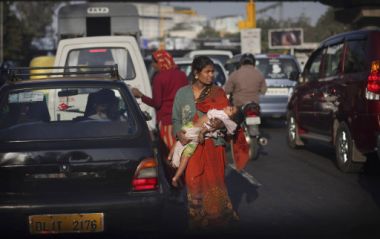Global suffering increases – Southern Asia worst hit

More people around the world are pessimistic about their current and future life circumstances, a global survey has found.
A Gallup poll that interviewed 230,083 people aged 15 or over across 143 countries last year concluded that the global trend in suffering has increased by three percentage points.
Of the individual regions studied, South Asia came out worst, with an increase of ten percentage points of suffering between 2010-2012 compared with 2006-2008 figures.
However, not everyone is doing so badly with Sub Saharan Africa and Latin America and the Caribbean showing decreases in suffering levels by four and two percentage points respectively.
The data is gathered using a simple survey called the Cantril Self-Anchoring Striving Scale. Gallup classifies respondents as "thriving", "struggling", or "suffering" according to how they rate their current and future lives on a ladder scale numbered from 0 to 10.
The increase of three percentage points is largely down to Southern Asia's large population and the poor economic performance of India, the region's most populous country.
India has seen its GDP growth slow substantially from 9.4% in the first quarter of 2010 to 4.4% in the second quarter of 2013, the worst quarterly growth rate since 2002.
As a result of this, India's suffering stats show an increase of 13 percentage points when comparing 2012-2010 results to those of 2006-2008.
The only other countries to have such a comparable or higher increase are Nepal (17 percentage points), Greece (13 percentage points) and Armenia (17 percentage points). Although its increase is on top of a much larger suffering population, with 37% of its population in the "suffering" bracket.
Gallup is positive about Latin America and Sub Saharan Africa, pointing out that "resource-oriented, emerging-market economies in both regions largely managed to avoid the recession that plagued more mature economies in Northern America and Europe".
The biggest drop is in Zimbabwe, where a drop of 38 percentage points of suffering between 2010-2012 and 2006-2008 has left only 5% of people describing themselves as "suffering".
Over the same time periods, Burkina Faso and Uganda dropped 14 and 13 percentage points respectively, while Zambia, Cameroon and Paraguay each dropped 10.
The main factors causing the increase in suffering, according to the Gallup report, link back to the global increases in unemployment since the 2008 financial crash. Although since 2010 the worldwide economy has rebounded, the growth has been too slow to recoup the loss in jobs, especially for the young.
Focusing on India, Gallup said: "The Indian government's failure to cut graft and red tape, as well as to liberalise its markets for labour, energy, and land, explains why the World Bank continues to rank the country as a bad place to do business.
"Now New Delhi is trying a different strategy to improve the wellbeing of its people.
"It just passed the Right to Food Act to provide food at subsidised rates to 71% of its population."











